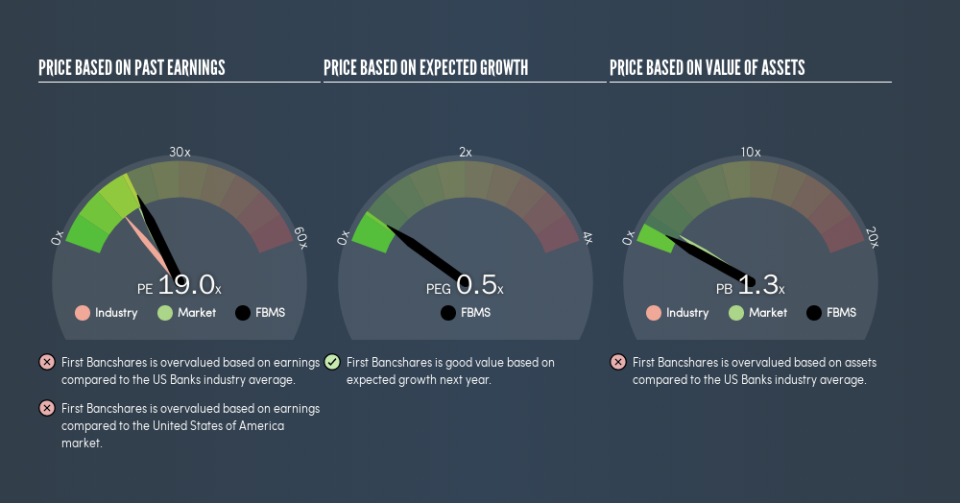Is The First Bancshares, Inc.'s (NASDAQ:FBMS) High P/E Ratio A Problem For Investors?

Want to participate in a research study? Help shape the future of investing tools and earn a $60 gift card!
This article is for investors who would like to improve their understanding of price to earnings ratios (P/E ratios). To keep it practical, we'll show how The First Bancshares, Inc.'s (NASDAQ:FBMS) P/E ratio could help you assess the value on offer. First Bancshares has a P/E ratio of 18.96, based on the last twelve months. That is equivalent to an earnings yield of about 5.3%.
See our latest analysis for First Bancshares
How Do I Calculate A Price To Earnings Ratio?
The formula for P/E is:
Price to Earnings Ratio = Price per Share ÷ Earnings per Share (EPS)
Or for First Bancshares:
P/E of 18.96 = $30.99 ÷ $1.63 (Based on the year to December 2018.)
Is A High P/E Ratio Good?
A higher P/E ratio means that investors are paying a higher price for each $1 of company earnings. That isn't necessarily good or bad, but a high P/E implies relatively high expectations of what a company can achieve in the future.
How Growth Rates Impact P/E Ratios
If earnings fall then in the future the 'E' will be lower. That means unless the share price falls, the P/E will increase in a few years. So while a stock may look cheap based on past earnings, it could be expensive based on future earnings.
Notably, First Bancshares grew EPS by a whopping 46% in the last year. And its annual EPS growth rate over 5 years is 5.4%. With that performance, I would expect it to have an above average P/E ratio. Unfortunately, earnings per share are down 7.4% a year, over 3 years.
How Does First Bancshares's P/E Ratio Compare To Its Peers?
We can get an indication of market expectations by looking at the P/E ratio. As you can see below, First Bancshares has a higher P/E than the average company (13) in the banks industry.
Its relatively high P/E ratio indicates that First Bancshares shareholders think it will perform better than other companies in its industry classification. Shareholders are clearly optimistic, but the future is always uncertain. So further research is always essential. I often monitor director buying and selling.
Don't Forget: The P/E Does Not Account For Debt or Bank Deposits
Don't forget that the P/E ratio considers market capitalization. Thus, the metric does not reflect cash or debt held by the company. Theoretically, a business can improve its earnings (and produce a lower P/E in the future), by taking on debt (or spending its remaining cash).
Spending on growth might be good or bad a few years later, but the point is that the P/E ratio does not account for the option (or lack thereof).
First Bancshares's Balance Sheet
First Bancshares's net debt is 7.2% of its market cap. It would probably trade on a higher P/E ratio if it had a lot of cash, but I doubt it is having a big impact.
The Bottom Line On First Bancshares's P/E Ratio
First Bancshares's P/E is 19 which is about average (17.7) in the US market. With only modest debt levels, and strong earnings growth, the market seems to doubt that the growth can be maintained. Because analysts are predicting more growth in the future, one might have expected to see a higher P/E ratio. You can taker closer look at the fundamentals, here.
Investors have an opportunity when market expectations about a stock are wrong. If the reality for a company is better than it expects, you can make money by buying and holding for the long term. So this free report on the analyst consensus forecasts could help you make a master move on this stock.
Of course you might be able to find a better stock than First Bancshares. So you may wish to see this free collection of other companies that have grown earnings strongly.
We aim to bring you long-term focused research analysis driven by fundamental data. Note that our analysis may not factor in the latest price-sensitive company announcements or qualitative material.
If you spot an error that warrants correction, please contact the editor at editorial-team@simplywallst.com. This article by Simply Wall St is general in nature. It does not constitute a recommendation to buy or sell any stock, and does not take account of your objectives, or your financial situation. Simply Wall St has no position in the stocks mentioned. Thank you for reading.

 Yahoo Finance
Yahoo Finance 
